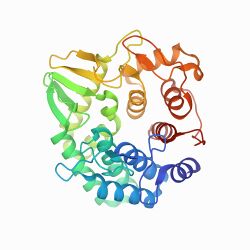Biology:Glucanase
| Glucanase | |||||||||
|---|---|---|---|---|---|---|---|---|---|
 3D crystalline structure of the endoglucanase Cel10 from Klebsiella pneumoniae. | |||||||||
| Identifiers | |||||||||
| EC number | 3.2.1. | ||||||||
| CAS number | 9015-78-5 | ||||||||
| Databases | |||||||||
| IntEnz | IntEnz view | ||||||||
| BRENDA | BRENDA entry | ||||||||
| ExPASy | NiceZyme view | ||||||||
| KEGG | KEGG entry | ||||||||
| MetaCyc | metabolic pathway | ||||||||
| PRIAM | profile | ||||||||
| PDB structures | RCSB PDB PDBe PDBsum | ||||||||
| |||||||||
| Glucanase | |
|---|---|
| Identifiers | |
| Symbol | Eng1p |
| CAS number | |
| PDB | 5GY3 |
| RefSeq | WP_012967086.1 |
| UniProt | A0A0J4VP90 |
| Other data | |
| EC number | 3.2.1 |
Glucanases are enzymes that break down large polysaccharides via hydrolysis. The product of the hydrolysis reaction is called a glucan, a linear polysaccharide made of up to 1200 glucose monomers, held together with glycosidic bonds.[1] Glucans are abundant in the endosperm cell walls of cereals such as barley, rye, sorghum, rice, and wheat.[1] Glucanases are also referred to as lichenases, hydrolases, glycosidases, glycosyl hydrolases, and/or laminarinases.[1] Many types of glucanases share similar amino acid sequences but vastly different substrates.[1] Of the known endo-glucanases, 1,3-1,4-β-glucanase is considered the most active.[1]
Structure
β-glucanases
The secondary and tertiary structures of β-glucanases involves the stacking of multiple β-sheets, each of which are made of several anti-parallel strands that bend and form a cleft crossing the active site of the enzyme.[1] This type of structure has been called the "jelly roll fold."
Some common β-glucanases
- 1,3-β-glucanases (laminarinases, EC 3.2.1.39)[1]
- Endo-1,3(4)-β-glucanase
- β-1,3-glucanase, an enzyme in plants that breaks down β-1,3-glucans such as callose or curdlan
- β-1,6 glucanase, an enzyme that breaks down β-1,6-glucans
- Cellulase, an enzyme that perform the hydrolysis of 1,4-beta-D-glycosidic linkages in cellulose, lichenin and cereal β-D-glucans.[2]
- Xyloglucan-specific endo-beta-1,4-glucanase
- Xyloglucan-specific exo-beta-1,4-glucanase
α-glucanases
- α-1,4-glucanase, an enzyme that breaks down α-1,4-glucans
- α-1,6-glucanase, an enzyme that breaks down α-1,6-glucans
- Pullulanase, a specific kind of glucanase that degrade pullulan
The functional formation of the enzyme-substrate complex is dictated by the induced-fit mechanism.[1]
Mechanism of Enzyme Action
The main function of glucanase is to catalyze the hydrolysis of glycosidic bonds in polysaccharides. This function is not highly specific, and the enzymes distinguish among substrates mostly by the types of bonds present and α- or β- configuration.[3]
In 1953, Dr. D. E. Koshland proposed a double-displacement mechanism for this enzyme action.[4] The first step of his proposed mechanism is rate-limiting step independent of the concentration of the substrate and involves an amino acid nucleophile and an acid/base catalyst.[4] In this step, the nucleophile, with help from the acid residue, displaces the aglycone and forms a covalent glycosyl-enzyme intermediate.[4][1] The second step involves a water molecule, assisted by the conjugate base of the acid catalyst, rendering the free sugar while retaining an anomeric configuration of the molecule.[1]
Glucanases can also catalyze transglycosylation, resulting in new β-glycosidic bonds between donor and acceptor saccharides.[1] This reaction, which has the same region- and stereo-specificity as the hydrolysis reaction, involves either the direct reversal of hydrolysis (known as condensation) or kinetic control of a glycosyl donor substrate.[1]
Microbial Occurrence and Agricultural Significance
Microbial Production
Bacteria such as Escherichia coli, and Bacillus spp. produce 1,3-1,4-β-glucanases in order to degrade and use polysaccharides from their environment as an energy source.[1] These bacterial glucanases are an example of convergent evolution as they share similarity or relation with plant glucanase primary, secondary, or tertiary structure.[1] Glucanases have also been found to be secreted by fungi such as Trichoderma harzianum, Saccharomyces cerevisiae and the anaerobic fungi Orpinomyces and Neocallimastigomycota, found in the digestive tracts of herbivores.[1][5][6] T. harzianum is also used as a fungicide, which is linked to the ability of its β-gluanases to hydrolyze phytopathogenic fungi via a mycoparasitic attack.[6]
Beer and Wine
Barley 1,3-1,4-β-glucanases are heat inactivated during malting, which can cause the build-up of high molecular-weight glucans which in turn result in reduced extract yield, lower filtration rates, and even gelatinous precipitates in the finished product. As a remedy, heat-resistant bacterial 1,3-1,4-β-glucanases are added.[1]
Used in enological practices during the aging process of wine, particularly when aged on lees with microxygenation. The enzyme aids in autolysis of yeast cells to release polysaccharides and mannoproteins, which is believed to aid in the color and texture of the wine.
Livestock Feed
In the production of feedstuff for broiler chickens and piglets, it has been found that β-glucanases improve digestibility of barley-based diets.[1]
References
- ↑ 1.00 1.01 1.02 1.03 1.04 1.05 1.06 1.07 1.08 1.09 1.10 1.11 1.12 1.13 1.14 1.15 1.16 "Bacterial 1,3-1,4-beta-glucanases: structure, function and protein engineering". Biochimica et Biophysica Acta (BBA) - Protein Structure and Molecular Enzymology 1543 (2): 361–382. December 2000. doi:10.1016/s0167-4838(00)00231-4. PMID 11150614.
- ↑ "The crystal structure of the endoglucanase Cel10, a family 8 glycosyl hydrolase from Klebsiella pneumoniae". Acta Crystallographica. Section F, Structural Biology Communications 72 (Pt 12): 870–876. December 2016. doi:10.1107/S2053230X16017891. PMID 27917834.
- ↑ "DMS35_22185 - Glucanase - Klebsiella variicola - DMS35_22185 gene & protein". https://www.uniprot.org/uniprot/A0A0J4VP90.
- ↑ 4.0 4.1 4.2 "Stereochemistry and the Mechanism of Enzymatic Reactions". Biological Reviews 28 (4): 416–436. 1953. doi:10.1111/j.1469-185X.1953.tb01386.x.
- ↑ "Eng1p, an endo-1,3-beta-glucanase localized at the daughter side of the septum, is involved in cell separation in Saccharomyces cerevisiae". Eukaryotic Cell 1 (5): 774–786. October 2002. doi:10.1128/EC.1.5.774-786.2002. PMID 12455695.
- ↑ 6.0 6.1 "Purification and characterization of a beta-Glucanase produced by Trichoderma harzianum showing biocontrol potential". Brazilian Archives of Biology and Technology 50: 21–29. January 2007. doi:10.1590/S1516-89132007000100003. http://www.scielo.br/j/babt/a/G4kGhLWdpwmJfr6jvNybzrf/?lang=en.
See also
- Glycoside hydrolases, a family of enzyme that cut a glycoside from a non-glycosidic molecule
- Glycoside hydrolase family 5
- Glycoside hydrolase family 16
- Glycoside hydrolase family 17
 |


